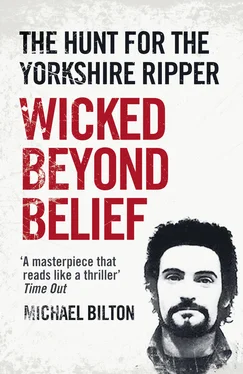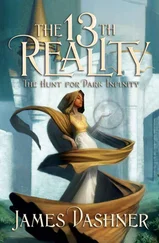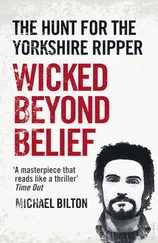This conviction generated two separate official records: the first at the West Riding Regional Criminal Record Office at Wakefield, the second at the Central Criminal Record Office at New Scotland Yard in London. Each record detailed Sutcliffe’s name, age, date of birth, address, description and information about the offence. More motoring convictions followed in 1965 and 1966, but these were never filed at the criminal record offices.
The next recorded criminal violation by Peter Sutcliffe was during the early hours of 30 September 1969, in the Manningham area of Bradford, close to the city’s red-light district. He was seen late at night sitting in a motor vehicle deliberately trying to be unobtrusive, with the engine running quietly and the lights switched off. When a police officer called Bland approached the vehicle, Sutcliffe immediately drove off at high speed. A search was carried out and the officer later found the car unattended a short distance away. When nearby gardens were searched, Sutcliffe was caught and arrested. In his possession was a hammer.
Questioned by police, he could not provide a satisfactory explanation for having the hammer, but denied criminal intent. He was charged only with the banal offence of going equipped to steal rather than being in possession of an offensive weapon. We now know from Peter Sutcliffe’s own words that he fully intended attacking a woman that night, but the police had no inkling of this. Two weeks later he pleaded not guilty at Bradford City Magistrates’ Court, but the case against him was found proved by the bench and he was fined £25, to be paid at £2 per week. The West Riding CRO based at Wakefield and the Bradford City Police, which had its own separate criminal records office, both listed this offence in their files as ‘Going equipped for stealing’, whereas their counterparts in the Central CRO at New Scotland Yard in London made crucial reference to: ‘Equipped for stealing (hammer)’ and listed under the heading ‘Method’ the words: ‘In possession of housebreaking implement by night, namely a hammer [my italics]’. The Bradford criminal record office carried a passport-size head and shoulders photograph of the offender, whereas the West Riding CRO had three pictures of Sutcliffe in his file – one full length, one head and shoulders facing the camera, a third in profile. All three clearly showed Sutcliffe had dark curly hair, a dark-coloured beard and moustache.
For his next court appearance several years later, Sutcliffe presented the dapper and somewhat discordant colourful image for which he had become infamous within his circle of friends and family. He wore black trousers, brown platform shoes, a leather jacket with a multicoloured shirt and a red tie. By now he was married to the daughter of Czech émigrés and living with his parents-in-law at Tanton Cresent, Clayton, Bradford. He and a friend, Michael Barker, had stolen five second-hand car tyres worth 50 pence each from Sutcliffe’s employer, the Common Road Tyre Company, where he worked as a driver. Sutcliffe had been employed as one of the firm’s tyre fitters. On 15 October 1975, the company reported him to the police, claiming he had stolen tyres from them. When arrested and questioned Sutcliffe immediately admitted the offence and opened up the boot of his car to reveal his booty. By the time he appeared at Dewsbury Magistrates Court on 9 February 1976 to admit a charge of simple theft, Sutcliffe was already a double murderer. But there was nothing to connect him with those crimes. He was fined £25.
The name of Peter William Sutcliffe would not, in fact, feature among the complex index card system in the murder incident room of the West Yorkshire Police ‘Ripper Squad’ until November 1977. Even then he was the subject of only a routine inquiry. But the fact remains that by the summer of 1976 the ‘face’ of the man who had killed twice and would go on to murder another eleven women was buried in a filing system. With the benefit of hindsight we now know he was a serial killer, but successful murder investigations are not about hindsight. They are about foresight, hunches, risks, intuition, leadership, good communication and, of course, a series of standard operating procedures which involve the time-consuming task of knocking on doors, asking questions and comparing the answers with other information in police files.
Yet the ‘face’ of the Ripper, and clues to what he looked like, were lying hidden in the police files of investigations into unsolved, unprovoked assaults on women and a fourteen-year-old schoolgirl at various locations across West Yorkshire during the preceding three and a half years. The victims had been attacked in similar ways by assailants bearing roughly the same description. Tragically for the women Sutcliffe subsequently killed or attempted to kill, for their families and for the children made motherless over the succeeding years, most of these horrendous assaults were never linked as part of any series. More crucially, police ignored the descriptions provided by survivors who had given near-perfect illustrations and helped to prepare photofits of a dark-haired man with a moustache and beard who looked uncannily like Sutcliffe. But in 1976 there was nothing to point to him as being more than a petty thief. When the photofits are seen together today – alongside a police mugshot of Peter Sutcliffe taken in September 1969 – it all looks so blindingly obvious.
It was nearly teatime in Wakefield one day in October 1998. An attractive woman approaching middle age, but whose striking good looks and long dark hair made her appear years younger, answered a knock at her front door. She spoke a few words with a researcher from a documentary film-making company who had called at her home unannounced. Within seconds she was in a state of shock and a feeling of coldness started to overwhelm her. Suddenly she had a flashback at the mention of a terrifying incident that had happened to her twenty-five years beforehand. In the intervening years she had spoken about it to very few people, pushing the subject to the back of her mind. The woman had since married, had two teenage children, and wished to maintain her anonymity. She invited the researcher into her neat, well-kept home. Ushering her into the lounge, she said in her quiet Scots accent: ‘I was sure I had been attacked by the Yorkshire Ripper, but nobody had ever confirmed the fact.’
She was nineteen years old in 1972, working as a clerk-typist in a local firm. It was December, two days before New Year’s Eve. ‘I remember it like it was yesterday,’ she went on. She was living on her own in a house in Westgate, at the bottom end of Wakefield. It was a ‘queer’ foggy night. She had been to ‘Dolly Grey’s’ for a drink, but left quite early, about 10.30 p.m., and begun walking down Westgate towards home. As she neared the train station she realized she was being followed. She looked back at the man, noticing his staring eyes, dark longish hair, and beard. She clearly remembers thinking he was up to no good.
With her heart thumping, she carried on walking, thinking carefully about which route to take when she got near home. She planned carefully in her mind which way to get to her house, because there was a beck running at the front of where she lived and she feared the man might throw her in. A few houses near by belonged to prison officers at Wakefield’s maximum security gaol, and she hoped against hope they might not have gone to bed.
Walking past a pub called The Swan with Two Necks, she toyed with the idea of going into one of the bars as people would still be on drinking-up time and she might know them and feel safe in their company. Then she had second thoughts, fearing they might wonder what on earth she was imagining. So she kept walking, still very anxious, and stuck to the middle of the pavement, trying to walk quickly past the ginnels – dark passageways that ran between some of the terraced houses.
Читать дальше












